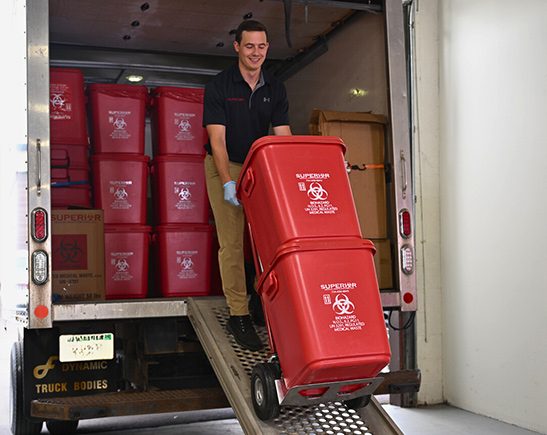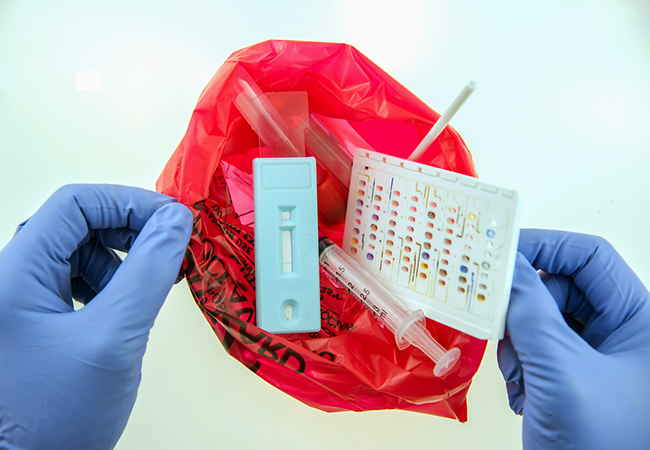Guardians of Cleanliness: Resident Medical Waste Removal Service for Your Comfort
Wiki Article
Keep Ahead of Regulations: Expert Guidance on Medical Garbage Disposal
In a globe where the healthcare industry is continuously progressing, it is important for medical centers to remain in advance of regulations when it comes to the appropriate disposal of clinical waste. With rigid standards and constant governing adjustments, it can be testing to browse the intricacies of this procedure. With skilled recommendations, centers can make sure compliance and reduce risks associated with inappropriate waste disposal. From recognizing the various classifications of medical waste to executing the right collection and partition approaches, this conversation will supply valuable understandings and workable ideas to aid facilities stay in advance of laws in the ever-changing landscape of medical waste disposal.Understanding Clinical Waste Categories
Understanding medical waste categories is essential for proper disposal and monitoring in health care facilities. Clinical waste refers to any kind of waste generated by health care activities that might position a hazard to public wellness or the setting. It is crucial to classify medical waste precisely to guarantee its secure handling, disposal, transport, and therapy.There are numerous classifications of clinical waste that health care centers need to be aware of. One of the most common classifications consist of transmittable waste, pathological waste, sharps waste, pharmaceutical waste, and chemical waste. Each classification has particular guidelines and laws for its correct management and disposal.
Contagious waste includes products contaminated with blood or various other bodily fluids, such as handwear covers, dress, and laboratory cultures. Pathological waste refers to human cells, organs, or body components that require special delivery and disposal. Sharps waste consists of used needles, syringes, and various other sharp objects that can trigger injury and transmit infections. Drug waste makes up expired, unused, or infected medicines that need mindful handling and disposal. Chemical waste consists of solvents, disinfectants, and other chemical substances used in healthcare facilities.
Remaining Up-To-Date With Regulatory Modifications
Remaining existing with regulative changes is important for healthcare centers to guarantee compliance and correct monitoring of medical waste disposal. medical waste removal. With policies regularly progressing, it is essential for health care centers to stay up-to-date to stay clear of charges, fines, and potential damage to the environment and public healthTo remain ahead of regulatory modifications, health care centers need to develop a system for surveillance and tracking updates. This can be done by registering for regulatory e-newsletters, attending conferences and workshops, and actively joining sector organizations. In addition, centers need to assign a team member or group liable for remaining informed and distributing details to relevant stakeholders.
Normal interaction with governing firms is also essential. Medical care facilities ought to develop partnerships with regional, state, and government agencies to ensure they understand any modifications in regulations that may affect their waste monitoring practices. This can be done with normal conferences, participation in public comment durations, and aggressive engagement with regulatory companies.
Additionally, medical care facilities need to think about partnering with waste management business that concentrate on medical garbage disposal (medical waste disposal services with WasteX). These companies are commonly fluent in the most recent policies and can offer support and assistance to make certain conformity
Implementing Proper Collection and Segregation Methods
To efficiently handle medical waste disposal, health care facilities should establish appropriate collection and segregation techniques based on regulatory guidelines. Implementing these methods ensures the safe handling and disposal of possibly unsafe products, secures the atmosphere, and reduces the risk of infections and injuries to healthcare workers and the basic public.
Correct collection and partition techniques involve making use of marked containers and classifying systems. Health care facilities should give plainly identified containers for different kinds of medical waste, such as sharps, infectious waste, pharmaceutical waste, and non-hazardous waste. These containers should be color-coded and plainly marked to avoid complication and promote easy recognition.
In addition, healthcare centers should educate their personnel on the appropriate treatments for gathering and segregating clinical read waste. This includes educating them on the various kinds of waste, the appropriate containers to make use of, and the significance of following policies and standards. Routine training sessions and refresher programs should be performed to guarantee that team member continue to be updated on ideal methods.
Furthermore, health care facilities must develop a system for routine collection and disposal of clinical waste. This may include partnering with licensed waste administration companies that focus on clinical waste disposal. These business will certainly guarantee that the accumulated waste is transferred and disposed of in compliance with governing requirements.
Selecting the Right Disposal Approaches

Incineration is among one of the most typical and reliable approaches for disposing of certain kinds of medical waste, such as pathological waste and sharps. It involves the regulated burning of waste at heats, decreasing it to ash. Incineration can release damaging contaminants into the air and contribute to air contamination.

Chemical therapy entails the usage of chemicals to decontaminate and counteract the waste. Microwave therapy makes use of microwave power to warmth and decontaminate the waste.
Ensuring Conformity With Documentation and Training
After meticulously thinking about the proper disposal techniques for clinical waste, health care facilities should guarantee compliance with regulations and minimize environmental impact by implementing effective documents and training treatments. This action is vital in preserving a risk-free and sustainable atmosphere for both healthcare employees and the basic public.
Healthcare workers that take care of clinical waste needs to receive suitable training on waste segregation, dealing with, and disposal procedures. By offering extensive training, healthcare facilities can encourage their personnel to make educated decisions and lessen the risk of inappropriate waste disposal.
Final Thought
In final thought, staying ahead of guidelines in medical garbage disposal is essential for healthcare facilities. medical waste removal service. Understanding the various classifications of clinical waste, staying updated with governing modifications, implementing proper collection and segregation techniques, selecting the proper disposal approaches, and guaranteeing compliance with documents and training are all important steps. By adhering to these guidelines, health care organizations can effectively take care of and get rid of of clinical waste in a responsible and risk-free fashioncheck From comprehending the different classifications of medical waste to applying the right collection and segregation methods, this conversation will certainly give actionable suggestions and valuable understandings to assist facilities remain ahead of laws in the ever-changing landscape of medical waste disposal. - medical waste disposal services with WasteX
The most typical classifications consist of contagious waste, pathological waste, sharps waste, pharmaceutical waste, and chemical waste. Health care facilities ought to provide clearly identified containers for different kinds of clinical waste, such as sharps, contagious waste, pharmaceutical waste, and non-hazardous waste. Medical care facilities ought to establish a detailed system to tape and track all facets of clinical waste disposal, consisting of kinds of waste generated, amounts, and disposal methods utilized. Healthcare employees who handle medical waste should receive appropriate training on waste segregation, handling, and disposal treatments.
Report this wiki page